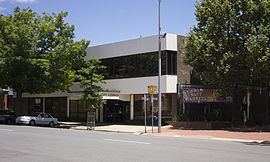Population 40,568 (2013 est) City of Queanbeyan Palerang | Last Mayor Tim Overall Area 172 km² Council seat Queanbeyan | |
 | ||
Abolished 12 May 2016 (2016-05-12) Points of interest Canberra Avenue, Queanbeyan Museum, Queanbeyan Printing Museum, White Rocks | ||
City of queanbeyan pipe band at anzac day 2
Queanbeyan City was a local government area located in south eastern New South Wales, Australia. The former area is located adjacent to Canberra and the Australian Capital Territory, the Queanbeyan River, the Molonglo River, the Kings Highway and the Sydney-Canberra railway.
Contents
- City of queanbeyan pipe band at anzac day 2
- Map of Queanbeyan City NSW Australia
- City of queanbeyan pipe band at anzac day 4
- Cities towns and localities
- Composition and election method
- Amalgamation
- References
Map of Queanbeyan City, NSW, Australia
On 12 May 2016 the Minister for Local Government announced dissolution of Queanbeyan City with immediate effect. Together with the Palerang Council the combined council areas were merged to establish the Queanbeyan-Palerang Regional Council.
The last Mayor of the Queanbeyan City Council was Tim Overall, an independent politician.
City of queanbeyan pipe band at anzac day 4
Cities, towns and localities
The Queanbeyan City Council area included the suburbs and villages of:
In 1998 Queanbeyan Council applied to have the localities of Letchworth, Larmer, Dodsworth and De Salis recognised as suburbs and these names were assigned by the Geographical Names Board of New South Wales. A more recent Council has had these names withdrawn.
Composition and election method
Until its dissolution, the Queanbeyan City Council was composed of ten Councillors, including the Mayor, for a fixed four-year term of office. The Mayor was directly elected while the nine other Councillors were elected proportionally as one entire ward. As of the election held on 8 September 2012, the makeup of the last Council, including the Mayor, was as follows:
The last Council, elected in 2012 and dissolved in 2016, in order of election, was:
Amalgamation
A 2015 review of local government boundaries recommended that the Queanbeyan City Council merge with adjoining councils. The NSW Government considered two options. The first option was to merge Queanbeyan Council with parts of the Palerang Council to form a new council with an area of 3,791 square kilometres (1,464 sq mi) and support a population of approximately 55,000. The alternative, proposed by Palerang Council on 29 January 2016, was for an amalgamation of the whole of Palerang with Queanbeyan Council. On 12 May 2016 the Minister for Local Government announced dissolution of Queanbeyan City with immediate effect. Together with the Palerang Council the combined council areas were merged to establish the Queanbeyan-Palerang Regional Council.
